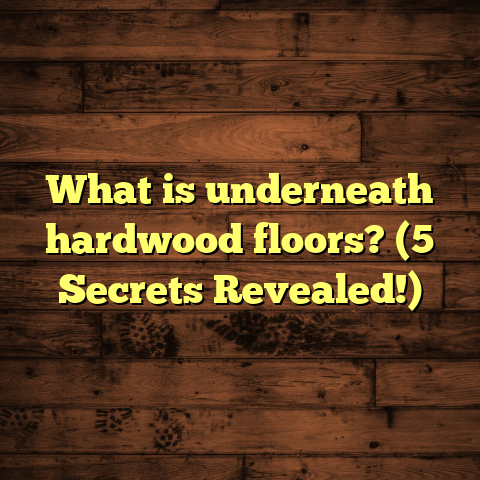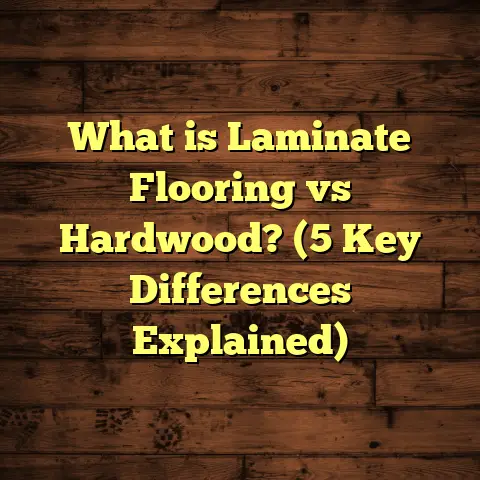What is a Concrete Floor? (5 Benefits for Your Home Design)
Comfort is something we all crave in our homes. When I think about comfort, I don’t just mean cozy furniture or soft lighting; I think about the foundation beneath my feet—the floor. The right flooring can completely change how a space feels and functions. Over the years, I’ve worked on many projects involving various types of floors, but concrete floors have stood out for their unique benefits. They offer a blend of durability, style, and practicality that few materials can match.
What is a Concrete Floor?
So, what exactly is a concrete floor? At its core, it’s a flat surface made by pouring and leveling a mixture of cement, water, sand, and gravel. Once this mixture hardens, it becomes a solid slab that serves as the base or finished surface in homes and buildings. But concrete floors aren’t just plain grey slabs anymore—they can be customized in countless ways to fit different design styles and functional needs.
When I first started using concrete floors in my projects, I was amazed by how versatile they are. From smooth polished finishes to stained or textured surfaces, concrete can be transformed to suit modern, rustic, or even industrial aesthetics. It’s not just about looks either—there’s a lot of strength and longevity packed into this material.
What surprised me early on was how many homeowners think concrete floors are cold and hard. While they can be if left untreated, there are so many finishing options and design techniques that make concrete floors inviting and warm underfoot. Plus, they can dramatically improve your home’s overall feel and function.
The Basics of Concrete Floors
Concrete floors usually start as a structural element—a slab poured over a prepared base like compacted soil or gravel. This slab can be left as-is or finished with coatings, stains, or sealers to enhance appearance and performance.
There are different types of concrete floors:
- Plain Concrete Slabs: Basic slabs often used in garages or basements.
- Polished Concrete: Ground down to a smooth shine with diamond tools.
- Stained Concrete: Colored with acid or water-based stains for decorative effects.
- Stamped Concrete: Imprinted with patterns to mimic stone, tile, or wood.
- Overlay Systems: Thin layers applied over existing floors for refinishing.
Each type has its own pros and cons. For example, polished concrete offers a modern look with minimal maintenance, while stamped concrete provides rich textures but may require more upkeep.
My First Concrete Floor Project
I recall my first big concrete floor installation vividly. It was for a small café downtown. The owner wanted something durable that could handle heavy foot traffic but also stylish enough to fit the trendy vibe. We chose polished concrete with a custom stain in earthy tones.
During installation, I learned that preparation is key—any imperfections in the slab will show through after polishing. We spent extra time grinding and patching minor cracks before moving to the finishing steps.
The result? A floor that looked sleek but still had character thanks to natural variations in the stain. The owner told me later how easy it was to keep clean during busy service hours. That project opened my eyes to the potential concrete floors hold both practically and aesthetically.
1. Durability That Lasts Decades
If you want a floor that truly stands the test of time, concrete is where I usually start. Over the years, I’ve seen countless floors take heavy wear without showing major damage.
Why Is Concrete So Durable?
Concrete’s strength comes from its composition—cement binds sand and gravel tightly together as it cures into a solid mass. This results in a surface that resists impact, pressure, and abrasion far better than wood or vinyl.
In fact, typical compressive strength for residential concrete floors ranges from 3,000 to 4,000 psi (pounds per square inch), but commercial-grade floors can exceed 5,000 psi. For context, hardwood typically doesn’t have anywhere near this level of compressive strength.
Real-Life Examples of Concrete Durability
One project that sticks in my mind was a warehouse conversion into an artist studio space. The original concrete floor had been there since the building was constructed in the 1950s—over 60 years ago! Despite decades of heavy machinery use and foot traffic, the slab was still solid with only minor surface wear.
When we refinished it with an acid stain and sealer, the floor looked brand new while retaining its robust base structure.
On another occasion, I worked on a family home where kids were constantly running around with toys and bikes inside the garage area. The homeowners worried about scratches and stains but found that their sealed concrete floor resisted damage remarkably well over several years.
What Does This Mean for Your Home?
Durability translates directly into cost savings over time because you won’t need frequent repairs or replacements. Concrete floors rarely chip or dent like wood does, and they don’t peel or bubble like some vinyl options can when exposed to moisture.
If you’re worried about cracks—typical in any concrete slab—I recommend proper installation techniques like control joints which direct cracking in harmless ways rather than random breaks.
Quick Tip: Ask your contractor about fiber reinforcement additives during slab pouring. These tiny fibers increase tensile strength and reduce cracking risk noticeably.
2. Easy Maintenance Saves Time and Money
One of the biggest reasons my clients choose concrete floors is how simple they are to care for compared to other materials.
What Does Concrete Floor Maintenance Look Like?
If your floor is sealed properly—which is essential—you mainly need to:
- Sweep or vacuum regularly to remove dirt.
- Mop occasionally with mild detergent and water.
- Wipe up spills promptly to avoid staining.
- Reseal every few years depending on wear.
That’s pretty straightforward compared to hardwood floors that need refinishing every decade or carpets requiring deep cleaning multiple times annually.
Data on Maintenance Savings
Based on industry reports, maintenance costs for sealed concrete floors average between $0.10 to $0.25 per square foot annually. Hardwood maintenance ranges from $1 to $3 per square foot due to refinishing and repairs.
Over 10 years on a 1,000 sq ft floor, you could save thousands simply by choosing concrete.
Personal Story: How Easy Maintenance Changed My Client’s Life
I had a client who owned a busy dog grooming business at home. With all the water splashes and pet hair flying around daily, she dreaded cleaning her old carpeted floors. When we installed sealed polished concrete instead, she told me it cut her cleaning time by more than half.
All she does now is sweep hair clumps and mop once a day—no more scrubbing at stubborn stains or worrying about odors trapped in carpet fibers.
Avoiding Common Maintenance Mistakes
- Don’t use harsh chemicals or acidic cleaners—they can degrade sealers.
- Avoid wax-based products; they leave residue.
- Use felt pads under furniture to prevent scratches.
- Regularly inspect sealers for wear spots and reseal those areas promptly.
3. Energy Efficiency Through Thermal Mass
This is one benefit that often surprises people but makes a huge difference in comfort and utility bills.
What Is Thermal Mass?
Thermal mass means the ability of a material to absorb, store, and release heat slowly over time. Concrete’s dense structure stores heat during warm parts of the day and releases it when temperatures drop—helping regulate indoor temperatures naturally.
How This Works in Real Homes
In warmer months, concrete floors feel cool because they absorb excess heat inside your home. In cooler months, they release stored heat slowly which reduces reliance on heaters.
I installed radiant heating systems beneath concrete slabs in several homes. The combination creates an even warmth that’s gentle on your feet without hot spots or drafts.
Energy Savings Backed by Data
According to research from the U.S. Department of Energy:
- Homes with high thermal mass flooring like concrete can reduce heating and cooling energy consumption by up to 20%.
- Radiant floor heating paired with concrete slabs can be 25%-30% more efficient than traditional forced-air heaters.
My Experience With Thermal Mass Floors
One winter, I visited a client’s house that had radiant heated polished concrete floors. Even when outside temperatures dropped below freezing, their living room floor stayed comfortably warm without cranking up the thermostat much higher than usual.
They reported saving about $200 per month on heating bills compared to previous winters with carpet flooring.
Practical Advice for Maximizing Thermal Benefits
- Pair your concrete floor with insulated sublayers to prevent heat loss downward.
- Consider radiant heating systems for added comfort.
- Choose finishes with good thermal conductivity like polished concrete instead of thick overlays that insulate heat away from living spaces.
4. Design Flexibility to Match Your Style
If you think concrete floors are boring grey slabs, think again! Concrete offers incredible design freedom that I love exploring with clients.
Decorative Options That Bring Your Floor to Life
- Staining: Acid stains react chemically with mineral content in concrete producing rich translucent colors—browns, blues, greens—to mimic natural stone hues.
- Dyeing: Water-based dyes offer brighter tones and patterns.
- Polishing: Grinding down progressively finer abrasives creates a shiny smooth finish that reflects light beautifully.
- Stamping: Imprinted patterns simulate brickwork, slate tiles, wood planks.
- Inlays: Embedding decorative aggregates like glass chips or shells adds sparkle and texture.
- Etching: Using acid solutions for artistic patterns or logos.
I always encourage clients to bring me inspiration photos because there are endless combinations possible based on their preferences.
Case Study: Coastal Cottage Floor
A family wanted their new beach house floor to capture ocean vibes without using traditional wood flooring prone to moisture damage near saltwater environments.
We opted for light blue acid-stained polished concrete with embedded shell fragments near entrance areas as subtle accents. It looked natural yet elegant—exactly what they wanted—and held up well over three years despite sandy feet constantly tracked inside.
Bringing Warmth Into Concrete Floors
Since some worry about coldness underfoot:
- Rugs strategically placed in living areas add softness and warmth without covering all the beauty.
- Warm tone stains or dyes create cozy color palettes.
- Combine with warm lighting and soft textiles throughout rooms for balance.
DIY Tips for Homeowners Interested In Concrete Floors
- Before committing fully, try small sample patches with stains or dyes on existing slabs.
- Work with skilled installers who understand decorative concrete techniques.
- Discuss sealing options carefully for desired sheen levels: matte vs glossy finishes impact room ambiance differently.
5. Allergy-Friendly and Healthy Living Environment
This is often overlooked but one of the biggest perks if you have family members sensitive to allergens or asthma sufferers.
Why Are Concrete Floors Better for Allergies?
Carpets trap dust mites, pet dander, pollen particles—all triggers for many allergy sufferers. They also hold moisture which encourages mold growth if not dried properly.
Concrete floors sealed well create smooth surfaces where allergens cannot embed deeply. They’re easy to clean thoroughly using regular sweeping and mopping so allergens get removed promptly instead of building up over time.
Studies Supporting Health Benefits
The Asthma and Allergy Foundation of America recommends hard surface floors like concrete or hardwood over carpets for managing indoor allergens effectively.
Homes with hard surface flooring report significantly lower dust mite populations compared to carpeted homes—reducing allergic reactions especially during peak seasons.
My Observations Working With Allergy-Prone Clients
Several clients have switched from wall-to-wall carpet to sealed polished concrete specifically for this reason. One family noticed fewer asthma flare-ups soon after installation because their indoor air quality improved dramatically due to reduced dust accumulation.
Additional Tips for Allergy-Safe Concrete Floors
- Use low-VOC sealers to avoid chemical irritants.
- Combine with HEPA-filter vacuums regularly for best results.
- Maintain humidity levels around 40%-50% inside home to inhibit mold growth further.
Installation Insights: What You Should Know About Putting Down Concrete Floors
Now that you know the benefits let’s talk about what installation actually involves—I always find this helps homeowners feel more confident about choosing concrete floors.
Preparing the Site
Good preparation is everything:
- Subgrade must be well-compacted to avoid settling cracks later.
- Vapor barriers installed below slabs prevent moisture from rising into flooring.
For existing slabs being refinished:
- Cracks repaired using epoxy injections or patching compounds.
- Surface cleaned thoroughly before staining or sealing.
Pouring vs Refinishing Existing Concrete
If you’re building new construction or major remodels:
- Pouring new slabs allows full customization including thickness (usually 4″-6″).
For remodels:
- Polishing or staining existing floors can be budget-friendly ways to update look without full replacement.
Installation Timeframe
Installing new concrete flooring typically takes several days:
- One day for site prep.
- One day for pouring slab.
- Several days curing time depending on climate (usually 7 days minimum before light foot traffic).
Polishing/staining/refinishing takes additional days based on complexity—from 2 days for basic polish up to a week for multi-step decorative finishes.
How I Use FloorTally To Manage Costs Efficiently
Budgeting flooring projects has always been challenging for me until I started using FloorTally regularly. It’s an online tool that simplifies cost estimation by incorporating local material prices and labor rates automatically.
This has been invaluable because:
- I get realistic quotes based on current market conditions—not just rough guesses.
- It factors waste percentages so I don’t over-order expensive materials.
- I can quickly compare how different finish options affect total cost.
For example: One recent project involved comparing polished vs stained finishes on a 1,200 sq ft slab. Using FloorTally helped me show my client clear cost differences upfront including labor—leading them to pick an option fitting their budget without sacrificing style.
With FloorTally’s help I’ve saved hours of back-and-forth calls with suppliers and avoided budget overruns multiple times.
Additional Tips To Maximize Your Concrete Floor Investment
Since you’re considering making this choice for your home:
- Always hire experienced contractors skilled in decorative concrete; poor installation means visible flaws later.
- Invest in quality sealers suited for your usage (matte finishes resist scratches better; glossy ones show dirt faster).
- Plan layout carefully if staining or stamping so patterns flow naturally across rooms.
- Consider combining concrete floors with area rugs in relaxation zones for added comfort.
Final Thoughts
Have you ever thought about how your floor affects your daily comfort? Concrete floors might not be first thing that comes to mind but they deliver strong advantages:
Durability that lasts decades without costly repairs; easy maintenance freeing up your time; energy efficiency cutting heating/cooling bills; design flexibility letting you express personal style; allergy-friendliness supporting healthier air quality at home.
If you want a floor combining beauty with lasting value—and something built tough enough to handle life’s ups and downs—I’d say give concrete floors serious thought.
Feel free to reach out if you want advice on specific finishes or maintenance routines tailored for your space!





